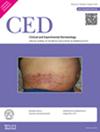Bullous drug eruption.
IF 2.8
4区 医学
Q1 DERMATOLOGY
引用次数: 0
大疱性药疹
急诊科接诊了一名 63 岁的女性患者,她在接受心导管手术后出现了播散性皮炎。她的既往病史包括接受血液透析的终末期肾病。临床检查发现,她的嘴唇和动静脉瘘管上有糜烂和出血结痂。此外,我们还发现她的左手手背和手掌上有五个色素沉着斑,生殖器部位有多个色素减退斑。在查阅病历时,我们发现该患者曾在使用造影剂后出现过大疱。根据临床病史、临床检查、爆发时限和药物激发试验阳性,诊断为放射性对比剂引起的固定药物爆发(FDE)。静脉注射造影剂的反应可以是即刻的,也可以是延迟的,延迟超敏反应(DHR)发生在用药后一小时到七天。迟发性超敏反应通常表现为斑丘疹。超敏反应很少见。皮肤试验可用于确定致病因子。理想情况下,皮内测试(延迟读数)和斑贴测试相结合,可获得最佳灵敏度。尽管缺乏标准化方案,但使用皮质类固醇进行预处理可减轻反应的严重程度。
本文章由计算机程序翻译,如有差异,请以英文原文为准。
求助全文
约1分钟内获得全文
求助全文
来源期刊
CiteScore
3.20
自引率
2.40%
发文量
389
审稿时长
3-8 weeks
期刊介绍:
Clinical and Experimental Dermatology (CED) is a unique provider of relevant and educational material for practising clinicians and dermatological researchers. We support continuing professional development (CPD) of dermatology specialists to advance the understanding, management and treatment of skin disease in order to improve patient outcomes.

 求助内容:
求助内容: 应助结果提醒方式:
应助结果提醒方式:


